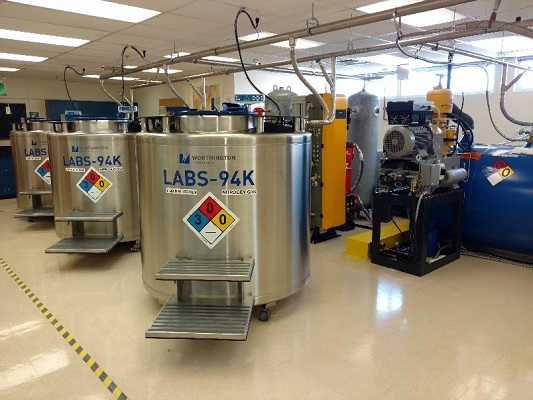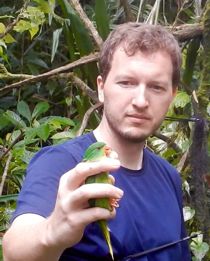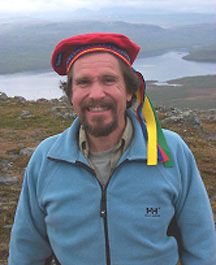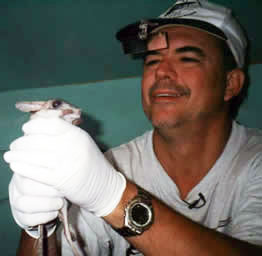Welcome to the Division Genomic Resources
The Museum of Southwestern Biology (MSB), Division of Genomic Resources (DGR) is a centralized repository at the University of New Mexico (UNM) for cryogenic biological materials submitted from MSB divisions at the University of New Mexico and from other individuals and institutions worldwide. The MSB DGR collection archives cryogenically preserved samples of animal tissues, whole organisms such as embryos and parasites, and purified DNA and RNA for the MSB divisions of Mammals, Birds, Fishes, Herpetology, and Parasitology. The MSB DGR collection contains over 500,000 cryogenic samples of more than 250,000 specimens and 3,000 species, representing Mammals (92%), Birds (4%), Reptiles (1%), Fishes (1%), and a growing collection of associated endo- and ectoparasites (2%). The collection spans more than 30 countries, with particularly strong holdings from the Southwestern United States, Beringia, and Latin America. Tissues and museum specimens can be located online by searching the Arctos collections database for each of the MSB divisions (See DGR Loan Policy).

The DGR collection is archived in three 94K vapor-phase nitrogen storage tanks at -190C and in fourteen -80C chest freezers. In 2016, National Science Foundation funding (Award# 1561342) as well as institutional funding from the University of New Mexico allowed for the initial upgrade from mechanical freezers to vapor-phase nitrogen storage. For the first phase of this upgrade through 2019, approximately 1/3 of the collection has been transferred to vapor phase nitrogen storage into 3 high efficiency stainless steel LABs 94K cryogenic freezer tanks. Nitrogen supply is provided by an on-site liquid nitrogen cryogenerator. Vapor-phase nitrogen freezer tanks provide more secure storage independent of electrical supply, providing up to 21 days of temperature control in the event of power failure. In addition, vapor phase nitrogen storage maintains ideal sample quality for the long term. Once funding is secured for additional cryotanks needed to complete the final phase of expansion, the DGR collection space will house 11 cryogenic freezer tanks capable of storing approximately 1,000,000 samples. Please see the DGR Loan Policy for details.
The overall mission of the MSB Division of Genomic Resources is to serve as a key component of the Museum of Southwestern Biology’s global research infrastructure by permanently preserving and maintaining a frozen tissue archive incorporating samples from all museum divisions. This archive contributes significantly to understanding the complexity of biological diversity and ecosystem function on local, regional, and global scales, and to addressing critical biological problems (e.g., emerging pathogens, habitat degradation, pollution, climate change, and invasive species). The world-class collections of MSB also are used in applied research (e.g., forensics) and in educational efforts to train and inspire the next generation of scientists. MSB DGR has grown at a consistent rate for the last 10 years. Currently, the increase in collection growth is approximately 12,000 specimens, or about 38,000 tubes per year (equaling the addition of one full ultra-low freezer annually). Over the last decade, use of MSB DGR specimens has averaged about 54 loans per year containing about 2,000 specimens to researchers world-wide. Access to the collection is now facilitated with the web-based database and collection management system (ARCTOS) which allows real time data entry, and the ability to share data across platforms and databases (e.g., GenBank, Google Earth). We are able to document and link MSB loans, link projects and resulting publications generated from the use of our specimens to each specimen record. We are also able to track and record the numerous projects, thesis, and dissertations that utilized MSB specimens. See the ARCTOS Collections Database for more information.
History of the Division

Mike Andersen became curator of Genomic Resources in 2017. Andersen is an avian evolutionary biologist, systematist, and biogeographer and is a dedicated field and museum biologist. He has contributed specimens to museums around the world and since 2005 has participated, led, and supported 14 international expeditions. He studies diversification of birds on South Pacific islands and his field program is supported by a National Science Foundation award to study terrestrial vertebrates of Melanesia. Andersen’s research lab at UNM combines specimen-based field work and molecular phylogenomics to examine the tempo and mode of rapid geographic radiations across the Pacific. He aims to reinterpret long-standing ecological and evolutionary hypotheses (e.g., modes of speciation, island biogeography, and community assembly of remote oceanic islands) in light of evidence from modern specimens and the evolutionary history of birds.

When Joseph Cook became Curator of Mammals in 2003, he added large series of tissues from mammal and parasite specimens to MSB DGR from the northern high latitudes (Alaska, Canada, Russia, Mongolia). These specimens were obtained through projects sponsored by a series of NSF grants (Beringian Coevolution Project I & II; Collaborative Investigations of Arctic Biomes) and support from state and federal agencies (US Fish and Wildlife Service, USDA Forest Service). The mammal portion of MSB DGR has more than doubled in size in the last decade to become the largest holdings worldwide. The MSB Bird Division started adding bird tissues under the direction of Dr. Robert Dickerman in the 1980s. In 2007, a new Bird Curator, Chris Witt, began to greatly increase the number of avian specimens from North America, Africa, Europe, and Peru under support from the NSF and other funding agencies. The MSB Fish and MSB Herpetology Divisions have archived tissues in MSB DGR as well over the last two decades, and additional samples are in the process of being transferred. The Division of Parasitology (MSB Para) established in 2012 has begun contributing frozen endo- and ectoparasites, many with host specimen vouchers in MSB Mammals and Birds.

In 1979, the Division of Mammals under Terry Yates began storing ultra-frozen tissues (heart, liver, and kidney) and karyotype materials that would later stimulate the formation of the Division of Genomic Resources. The cryogenic collection remained ancillary to the MSB Mammal and Bird divisions until 1996 when MSB DGR was established as a separate division of MSB. Dr. Yates served as curator of MSB DGR until his unexpected death in 2007. In 2008, Dr. Joseph Cook became Interim Curator of the Division of Genomic Resources and was appointed Curator in 2012. Over the past four decades the largest acquisitions have been from the MSB Mammal and Bird divisions, including a large number of specimens from many countries. Historically, these divisions had field projects in the United States and elsewhere that were funded from NSF, CDC, NIH and other sources and resulted in large accessions of materials to DGR. In 1989, support from NSF established a Long-term Ecological Research site (LTER) on the Sevilleta National Wildlife Refuge. From 1990 to 2004, series of local mammals, birds, amphibians (with their corresponding tissue samples), arthropods, and plants were contributed annually to the MSB collections. Those specimens are accompanied by large amounts of ecological and climatic data. From 1994-2007 a series of CDC grants to MSB funded a project entitled “Longitudinal Studies of Rodent Reservoirs of Hantaviruses in the Southwestern United States.” Soon after, a National Institutes of Health (NIH) grant to study the “Ecology of Infectious Diseases,” and a NSF grant entitled “Ecological Drivers of Rodent-borne Disease Outbreaks: Trophic Cascades and Dispersal Waves” 2003-2009, and other collaborative NIH funded investigations of Hantavirus in Chile and Panama were funded. Those research projects resulted in the massive influx, processing, and installation of specimens in MSB DGR.






